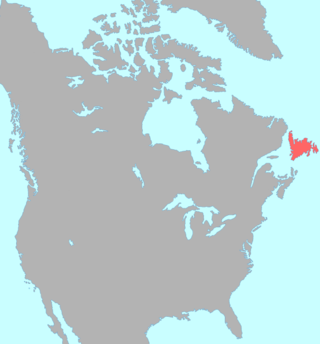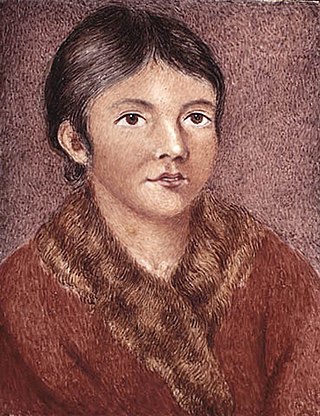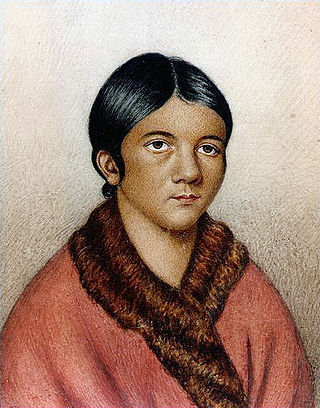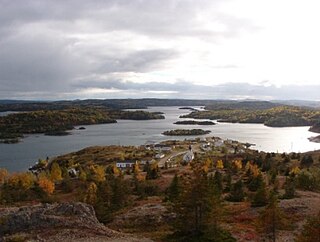Related Research Articles

Newfoundland and Labrador is the easternmost province of Canada, in the country's Atlantic region. The province comprises the island of Newfoundland and the continental region of Labrador, having a total size of 405,212 km2 (156,453 sq mi). As of 2024 the population of Newfoundland and Labrador was estimated to be 545,247. The island of Newfoundland is home to around 94 per cent of the province's population, with more than half residing in the Avalon Peninsula. Labrador shares a land border with both the province of Quebec and the territory of Nunavut on Killiniq Island. The French overseas collectivity of Saint Pierre and Miquelon lies about 20 km (12 mi) west of the Burin Peninsula.

The Beothuk were a group of Indigenous people of Canada who lived on the island of Newfoundland.

Beothuk, also called Beothukan, is an extinct language once spoken by the indigenous Beothuk people of Newfoundland. The Beothuk have been extinct since 1829, and there are few written accounts of their language. Hence, little is known about it, with practically no structural data existing for Beothuk.

Demasduit was a Beothuk woman, one of the last of her people on Newfoundland.

Shanawdithit, also noted as Shawnadithit, Shawnawdithit, Nancy April and Nancy Shanawdithit, was the last known living member of the Beothuk people, who inhabited Newfoundland, Canada. Remembered for her contributions to the historical understanding of Beothuk culture, including drawings depicting interactions with European settlers, Shanawdithit died of tuberculosis in St. John's, Newfoundland on June 6, 1829.
David Buchan was a Scottish naval officer and Arctic explorer.
William Epps Cormack was a Scottish explorer, philanthropist, agriculturalist and author, born St. John's, Newfoundland. Cormack was the first person of European descent to journey across the interior of the island. His account of his travels was first published in Britain in 1824. Interested in studying and trying to preserve Native culture, he founded the Beothuk Institution in 1827.
Nonosabasut was a leader of the Beothuk people. Family head and partner of Demasduit, born on the island of Newfoundland. Sometimes referred to as Chief Nonosabasut, his stature within the last remaining Beothuk would better be described as that of a headman or leader.

Boyd's Cove, also known as Boyd's Harbour, is a local service district and designated place in the Canadian province of Newfoundland and Labrador that is near Lewisporte. There is an interpretive centre dedicated to the earlier indigenous Beothuk settlement at this location.
Noel Joseph JeddoreWe’jitu also Newell Jeddore Gietol, Geodol was Saqamaw "grand chief" of the Mi'kmaq at Miawpukek in Bay d'Espoir on the south coast of Newfoundland in the Coast of Islands region. Jeddore served as chief from July 26, 1919 until he was forced into exile to Eskasoni, Nova Scotia, in 1924. He was born at Indian Point, Bay d'Espoir and he died at Eskasoni, Cape Breton.

Pilley's Island is a town located on the island of the same name in the Canadian province of Newfoundland and Labrador. It is located in Division No. 8, Newfoundland and Labrador.

The province of Newfoundland and Labrador covers the period from habitation by Archaic peoples thousands of years ago to the present day.
Grand Lake is a large lake in the interior of the island of Newfoundland, in the Canadian province of Newfoundland and Labrador. It has an area of 543 km2 (210 sq mi), making it the largest lake on Newfoundland. Contained within the lake is the 18th largest lake-island in the world, Glover Island.

Michael Francis Howley was a Roman Catholic priest. He was Bishop of St. John’s, Newfoundland from 1895 until 1904, when he was elevated to Archbishop of St. John’s, Newfoundland, a post he held until his death in 1914.

The Fishermen's Protective Union was a workers' organisation and political party in the Dominion of Newfoundland. The development of the FPU mirrored that of the United Farmers movement in parts of Canada.

Newfoundland is a large island within the Canadian province of Newfoundland and Labrador. It is situated off the eastern coast of the North American mainland and the geographical region of Labrador.
John Peyton Sr. (1749–1829) was an English-born fisherman and trapper in the Colony of Newfoundland.

The art of Newfoundland and Labrador has followed a unique artistic trajectory when compared to mainland Canada, due to the geographic seclusion and socio-economic history of the province. Labradorian art possesses its own historical lineage.
Newfoundland Quarterly is a literary magazine published by Memorial University of Newfoundland in St. John's, Newfoundland and Labrador, Canada. Having begun as "a literary magazine of interest to Newfoundlanders at home and abroad," Newfoundland Quarterly today calls itself "a cultural journal of Newfoundland and Labrador", and publishes articles on the province's culture and history, including biography, local history, book reviews, visual art and poetry. Founded in 1901, it is Canada's longest running magazine.

The islands of Newfoundland and Ireland, in addition to sharing similar northern latitudes and facing each other across the Atlantic Ocean, also had in common, during the middle of the 19th century, a heavy dependence on a single agricultural crop, the potato—a dependence that allowed the same blight that precipitated the Great Famine in Ireland to wreak havoc on this former British colony as well. Though acute, and the source of great suffering, the famine in Newfoundland lasted for fewer years than its Irish contemporary, which extended from 1845 to 1849. Beginning a year later, in 1846, it ended with the return to prosperity of the local fisheries in the spring and summer of 1848.
References
- ↑ "James Patrick Howley (1847-1918), Parks Canada backgrounder, Feb. 15, 2016". Archived from the original on 2016-03-03. Retrieved 2016-02-22.
- ↑ "Howley Family". Memorial University.
- ↑ Kirwin, W.J.; O'Flaherty, P.A., eds. (May 2009), Reminiscences of Forty-two Years of Exploration in and about Newfoundland (PDF), St. John's, Newfoundland: Memorial University of Newfoundland, p. 2158, retrieved August 6, 2016